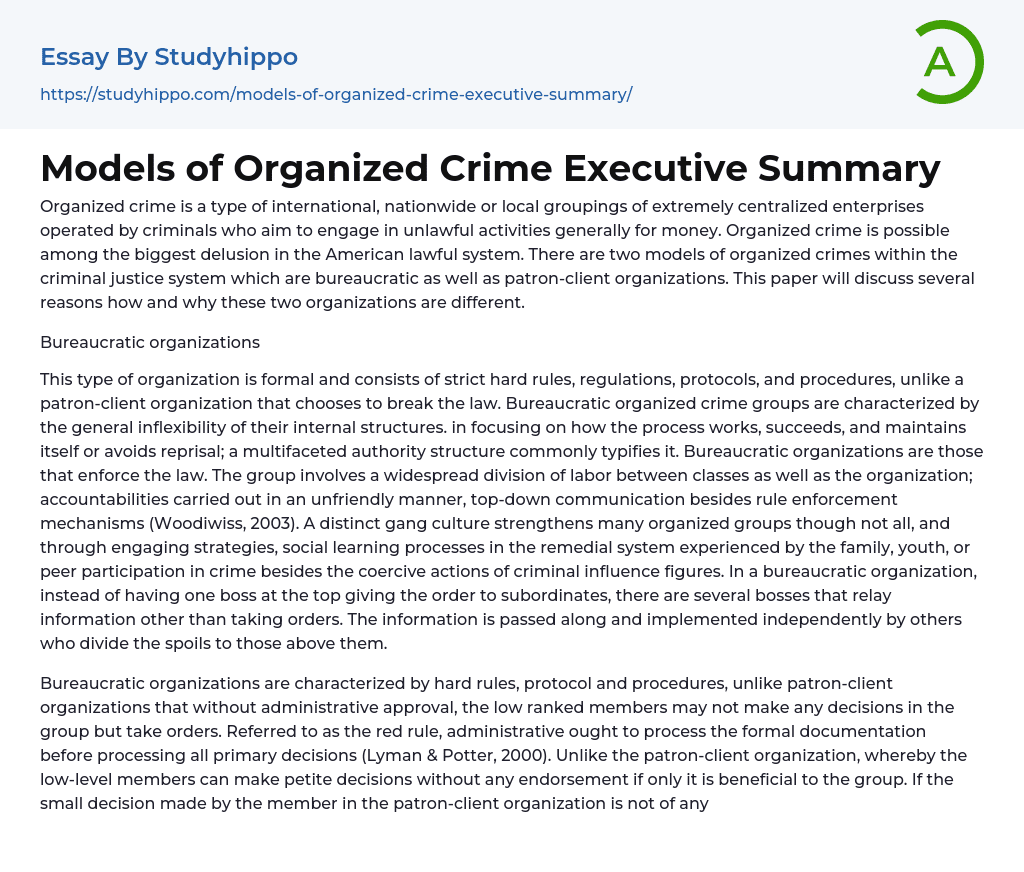

Models of Organized Crime Executive Summary Essay Example
Organized crime comprises international, nationwide, or local groups of highly centralized enterprises run by criminals seeking to participate in illegal activities, typically for financial gain.
Organized crime in the American legal system is a widespread misconception. Within the criminal justice system, there exist two models of organized crime: bureaucratic organizations and patron-client organizations. This paper aims to explore the differences between these two types of organizations.
Bureaucratic organizations
Bureaucratic organizations are characterized by their formal structure, which includes rigid rules, regulations, protocols, and procedures. In contrast, patron-client organizations opt to engage in illegal activities.
Bureaucratic organized crime groups exhibit a rigid internal structure and a complex authority system. These groups primarily focus on understanding and maintaining their processes to avoid retaliation. They enforce the law and rely on a division of labor and hierarchical communication to carry out th
...eir responsibilities. While many organized groups have a distinct gang culture, not all of them do. Additionally, these groups utilize social learning processes within the family, youth, and peer involvement in criminal activities, as well as the coercive actions of influential criminal figures.
Bureaucratic organizations differ from patron-client organizations in terms of their hierarchical structure and decision-making processes. In a bureaucratic organization, multiple bosses relay information rather than giving direct orders to subordinates. The information is then independently implemented by others, who share the rewards with their superiors. Bureaucratic organizations have strict rules, protocols, and procedures. In contrast, patron-client organizations require administrative approval for all major decisions. This formal documentation process, known as the red rule, precedes primary decision-making. However, in patron-client organizations, low-ranking members are allowed to make minor decisions without endorsement as long as they benefit the group. If these
actions do not benefit the group, members may face reprimands. (Lyman & Potter, 2000).
In a bureaucratic organization, the blame for financial troubles rests solely on the administrations, whereas in a patron-client organization, everyone is financially liable and all members are involved. The success or failure of the organization is entirely dependent on this group (Lyman & Potter, 2000). Bureaucratic organizations align more with the law, while also assisting organized crime in understanding how to function and succeed effectively.
Patron-client organizations
This group consists of criminal patrons who exchange information and establish a successful network involving main bosses and influential political figures. The patron-client network is structured hierarchically with a leading boss, underboss, captains, an advisor, and members. The top boss gives orders to the underboss, who then relays the information to the captains. The captains delegate tasks to their lackeys responsible for carrying out the organization's illicit activities.
All members of the patron-client organization must go through prior initiation (Lyman ; Potter, 2000). These organizations are similar to close-knit families within the top tier, but this closeness extends to all members at the lower level. Consequently, the top figures in the organization are more likely to evade detection and apprehension from the justice system due to the indistinctness resulting from this closeness.
Both the patron-client and bureaucratic models employ their own methods to maintain order. While the bureaucratic model focuses on enforcing rules, the patron-client organization is rooted in traditional values. Both organizations are willing to use force to punish those who transgress their boundaries (Woodiwiss, 2003). Additionally, both models engage professionals in illicit activities to enhance their profitability and authority. Although the bureaucratic organization
excels in task completion, it is the patron-client model that is renowned for its ability to evade police detection.
Both similar and different, these models of criminal organizations aim to enhance law enforcement and professionals' understanding of the formation of criminal groups within domestic and international contexts. Professional sociologists, criminologists, and psychologists employ these models to bolster their research and present compelling arguments in society. Each model possesses distinct features that enable researchers to unravel the growth process of criminal groups and comprehend the reasons behind their success (Lyman & Potter, 2000).
From these models, it is evident that both legal and unlawful organizations have one major purpose, which is to acquire profit. Many of these organized crime groups are large, and law enforcement often utilizes bureaucratic and patron-client models. This is because law enforcement officials can better understand the networks involved in extensive criminal investigations. By understanding these crime syndicates and being able to apply models in various areas, law enforcement cannot anticipate a decrease in organized crime groups.
References
- Woodiwiss, M. (2003). Organized crime and American power: A history.
- Lyman, M., & Potter, G. (2000). Organized crime. Upper Saddle River, N.J.: Prentice Hall.
Toronto, among other locations, is the home of the University of Toronto Press.



